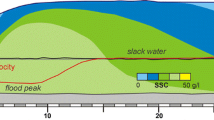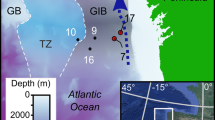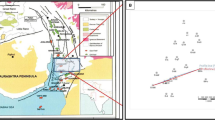Abstract
The sedimentary record in Muir Inlet, a macrotidal fjord in Alaska, is dominated by cyclic silt–mud rhythmites. Couplet thicknesses vary systematically in a vertical sequence and reflect a semidiurnal tidal regime. Semimonthly, monthly, bimonthly, and annual cycles can be identified both visually in cores and by spectral frequency analysis. An average annual sedimentation of 22.5 cmyr-1 occurs over a four-month meltwater season and is confirmed by 210Pb dating. These modern deep-water tidal rhythmites can be used to verify interpretations made on ancient rhythmites in the stratigraphic record, and they also provide a dating tool to interpret high latitude successions for high-resolution climate change.
Similar content being viewed by others
Author information
Authors and Affiliations
Additional information
Received: 20 February 1997 / Revision received: 1 October 1997
Rights and permissions
About this article
Cite this article
Cowan, E., Cai, J., Powell, R. et al. Modern tidal rhythmites deposited in a deep-water estuary. Geo-Marine Letters 18, 40–48 (1998). https://doi.org/10.1007/s003670050050
Issue Date:
DOI: https://doi.org/10.1007/s003670050050




